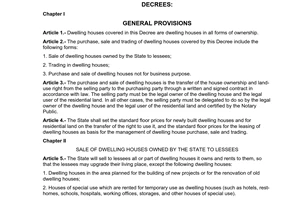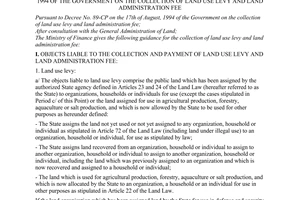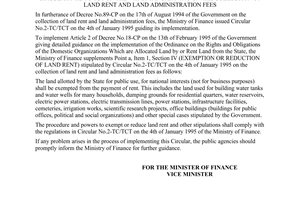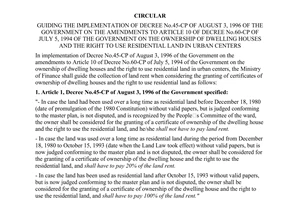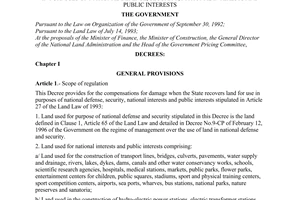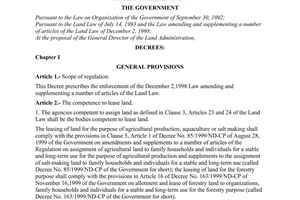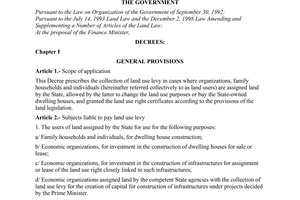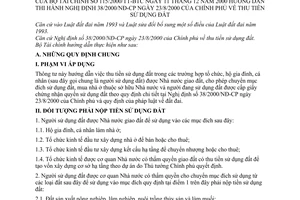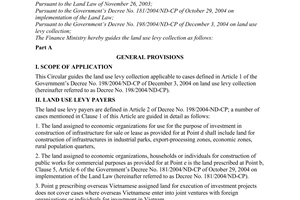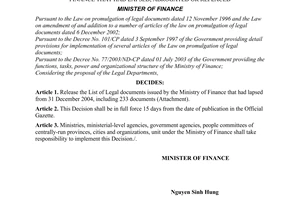Circular No.115/2000/TT-BTC of December 11, 2000 guiding the implementation of The Governments Decree No. 38/2000/ND-CP of August 23, 2000 on the collection of land use levy đã được thay thế bởi Circular No.117/2004/TT-BTC of December 7, 2004 guiding the implementation of The Government’s Decree No. 198/2004/ND-CP of December 3, 2004 on land use levy collection và được áp dụng kể từ ngày 10/01/2005.
Nội dung toàn văn Circular No.115/2000/TT-BTC of December 11, 2000 guiding the implementation of The Governments Decree No. 38/2000/ND-CP of August 23, 2000 on the collection of land use levy
|
THE
MINISTRY OF FINANCE |
SOCIALIST
REPUBLIC OF VIET NAM |
|
No: 115/2000/TT-BTC |
Hanoi, December 11, 2000 |
CIRCULAR
GUIDING THE IMPLEMENTATION OF THE GOVERNMENT’S DECREE No. 38/2000/ND-CP OF AUGUST 23, 2000 ON THE COLLECTION OF LAND USE LEVY
Pursuant to the 1993 Land Law and the Law
Amending and Supplementing a Number of Articles of the 1993 Land Law;
Pursuant to the Government’s Decree No. 38/2000/ND-CP of August 23, 2000 on the
collection of land use levy;
The Finance Ministry hereby guides the implementation thereof as follows:
A. GENERAL PROVISIONS
I. SCOPE OF APPLICATION
This Circular guides the collection of land use levy in cases where organizations, family households and individuals (hereinafter referred collectively to as land users) are assigned land and permitted by the State to change land use purposes or purchase the State-owned dwelling houses and the current land users are granted land use right certificates according to the detailed regulations in the Government’s Decree No.38/2000/ND-CP of August 23, 2000 and the provisions of the land legislation.
II. SUBJECTS LIABLE TO PAY LAND USE LEVY
1. The users of land assigned by the State for use for the following purposes:
1.1. Family households and individuals, for dwelling house construction;
1.2. Economic organizations, for investment in the construction of dwelling houses for sale or lease;
1.3. Economic organizations, for investment in the construction of infrastructures for transfer or lease;
1.4. Economic organizations assigned land by the competent State agencies with the collection of land use levy for the creation of capital for construction of infrastructure under projects decided by the Prime Minister.
2. Land users that are permitted by the competent State agencies to change the use purposes prescribed for land of the following categories into the purposes defined at Point 1 above shall have to pay land use levy:
2.1. Land for agricultural production, forestry, aquaculture and salt-making;
2.2. Land used for purposes of national defense, security, national interests or public interests;
2.3. Special-use land, land used for public-utility purposes and land of other categories, which had been assigned previously without payment of land use levy;
2.4. Land already leased by the State.
3. Current land users that have not yet obtained valid papers on land use right but are now granted the land use right certificates by the competent State agencies, except for cases otherwise prescribed by law.
4. Current land users that are allowed to purchase the houses they are renting, the liquidated or priced houses, which are under the State ownership, except for cases otherwise prescribed by law.
III. SUBJECTS NOT LIABLE TO PAY LAND USE LEVY
1. Users of land assigned by the State according to the provisions of Article 7 of the Government’s Decree No.04/2000/ND-CP of February 11, 2000 on the implementation of the Law Amending and Supplementing a Number of Articles of the Land Law (hereinafter called Decree No.04/2000/ND-CP for short), more concretely as follows:
1.1. Organizations assigned land by the State, including:
a/ Organizations assigned land with forests for management and assigned land for planting head-water protective forests; protective forests against wind and sand, protective forests against tidal waves and for seaward encroachment; and eco-environmental protection; and organizations assigned by the State to manage national parks, nature conservation forests or cultural-historical-environmental forests.
b/ State enterprises that are currently using land assigned by the State before January 1, 1999 for the purposes of agricultural production, forestry, aquaculture and salt-making.
c/ State agencies, political organizations, socio-political organizations and people’s armed force units that use land for the construction of their working offices; for national defense or security purpose; for the construction of projects in public-service economic, cultural, social, scientific-technical and foreign affairs sectors and domains; and organizations assigned to manage land with classified historical and/or cultural relics;
d/ Organizations that use land for such public-utility purposes as:
+ Construction of traffic roads, bridges, culverts, pavements, water supply or drainage systems, rivers, lakes, dikes, dams, schools, hospitals, markets, parks, flower gardens, playgrounds for children, public squares, stadiums, airports, ports.
+ Construction of electric power plants, trans-former stations, hydroelectric power plants’ reservoirs, communication lines, electricity transmission lines, petrol and oil pipelines, gas pipelines, hydrological and meteorological stations, observatories in service of research and public utility, irrigation works, wharves, car terminals, ferry landing stages, railway stations, national parks, sanatoria, fostering centers for children in plights, physical culture and sport training and exercise establishments, functional rehabilitation centers for disabled children, job-training centers, cultural works, monuments, memorials, clubs, theaters, museums, exhibition centers, cinemas, circus, detoxification centers for drug addicts, reformatories, graveyards, cemeteries, waste treating quarters, garbage dumping sites.
1.2. Family households and individuals that directly use land for the purposes of agricultural production, forestry, aquaculture and/or salt-making according to the provisions of the land legislation.
1.3. Religious organizations that are using land.
2. Land users that are leased land by the State.
3. Current land users that hold valid papers on land use right according to the provisions of Article 3 of the Government’s Decree No.17/1999/ND-CP of March 29, 1999 on the procedures for exchange, transfer, lease, sublease and inheritance of the land use right as well as for mortgage of and capital contribution with the land use right value (hereinafter called Decree No.17/1999/ND-CP for short) and detailed provisions of Section IV, Part A of this Circular, shall be granted land use right certificates or have their granted land use right certificates renewed for the whole land area being used in conformity with the said papers, except for cases of land use right transfer effected after October 15, 1993, which shall comply with the provisions of Article 7 of Decree No.38/2000/ND-CP or the provisions of the Law on Land Use Right Transfer Tax.
4. Land users that are allowed to purchase the State-owned houses in cases where such houses are liquidated or priced for sale to the current tenants before July 5, 1994 (date of promulgation of the Government’s Decree No.61/CP on dwelling house purchase, sale and business), provided that they have fully paid money therefor as prescribed and the selling prices are already inclusive of the factor of the house location or the land use levy, or the liquidation or pricing papers state the house area on the land area in use. For the remaining land area currently in use, 40% of the land use levy must be paid to the State.
5. Current land users that have fully paid the land use levy as prescribed at the time of land allotment and are permitted by the competent State agencies to change the use purposes for dwelling house or project construction.
6. If organizations, family households and individuals, that have been assigned land by the State without having to pay land use levy for the land area used for the purposes prescribed in this Section, use a part of the whole assigned area for production and/or business activities or dwelling house construction, they shall have to switch to lease land or pay the land use levy for such area according to the provisions of the land legislation.
IV. VALID PAPERS ON LAND USE RIGHT
Papers determined as valid are those specified in Article 3 of Decree No.17/1999/ND-CP specifically:
1. Land assignment or land lease decisions of the competent State agencies made according to the provisions of the land legislation;
2. Papers issued by the State agency(ies) competent to assign or lease land in the process of implementation of the land policies in the periods of the State of the Democratic Republic of Vietnam, the Provisional Revolutionary Government of the Republic of South Vietnam and the State of the Socialist Republic of Vietnam, provided that the land assignees or land lessees have been using the assigned or leased land incessantly since then;
3. Provisional land use right certificates which have been granted by competent State agencies or registered in the land administration books without any dispute;
4. Papers granted by competent agencies of the former regimes to the land users that have been using such land continuously since then without any dispute;
5. Papers on house and/or land inheritance, offer or donation with certification by commune, ward or district township People’s Committees, and such land is dispute-free;
6. The People’s Court’s judgments or decisions or the competent State agencies’ land-dispute settling decisions, that have taken legal effect.
7. Papers on the hand-over of houses of gratitude;
8. Papers on land transfer or dwelling house sale/purchase accompanied by the land use right transfer, provided that such papers have been verified by commune, ward, district township People’s Committees, which then conclude that the land is dispute-free, and the verification result has been certified by district, provincial capital or provincial town People’s Committees.
V. BASES FOR DETERMINATION OF LAND USE LEVY
Bases for determination of land use levy are the land area, land prices and land use levy rates.
1. Land area
- Land area calculated in square meter (m2) for land use levy is the land area assigned by the State with permission to change its for use purpose change or considered for the granting of land use right certificate to the current user; the land area closely attached to houses in case of liquidation, pricing and purchase of currently rented State-owned houses.
- Organizations assigned land by the State for doing business in dwelling houses or infrastructure and holding the competent State agencies’ land assignment decisions, which state that the land area is used for public-utility purposes, shall not have to pay land use levy for such public-utility land area.
- Residential land limit for land use levy calculation is the residential land limit set for each family household by the People’s Committees of the provinces or centrally-run cities. Residential land limits for individuals shall be conducive to their permanent residence registrations.
2. Land prices
- Land prices, calculated in Vietnam dong per square meter (dong/m2), shall be set by the People’s Committees of the provinces and centrally-run cities according to the Government’s price bracket for different land categories, and determined according to current land price indexes of localities at the time of issuing land use levy payment notices.
- Land price for land use levy calculation in case of land auction shall be the auction winning price.
- In cases where the competent State agencies permit the change of the use purposes of land of the categories eligible for land use levy exemption into residential land or land for construction of projects liable to land use levy payment, the land use levy shall be calculated according to the prices of residential land or project construction land.
- For organizations assigned land for investing in infrastructure construction, the land prices for land use levy calculation shall be those at the time of land assignment. In cases where a land block (plot) has already been planned for infrastructure investment, thus causing the land price change, the provincial People’s Committee shall reset an appropriate land price.
3. The land use levy rates:
The land use levy rates are prescribed for specific cases in Part B of this Circular.
B. LAND USE LEVY RATES
I. LAND USE LEVY RATES FOR CASES WHERE THE LAND IS ASSIGNED BY THE STATE
1. Users of land assigned by competent State agencies for use for the purposes defined in Clause 1, Article 2 of Decree No.38/2000//ND-CP and guided at Point 1, Section II, Part A of this Circular, that do not have to pay compensation for land-related damage to people having land recovered, shall have to pay 100% of the land use levy.
Where they have to pay compensation for land-related damage to people having land recovered, their actual compensation amount shall be deducted from the payable land use levy amount, but the deduction level shall not exceed 90% of the land use levy amount payable to the State budget.
Expenses for compensation for land-related damage (excluding compensation for damage to crops and assets on land, monetary supports for movement of assets and resettlement, etc.) shall be determined according to the provisions of the Government’s Decree No.22/1998/ND-CP of April 24, 1998 on compensations for damage incurred due to recovery of land by the State for use for national defense or security purpose, or for national or public interests.
2. For cases where organizations (including armed force units), which had been assigned land for construction of dwelling houses before October 15, 1993 (the effective date of the Land Law), have not yet paid the land use levy or their already paid land use levy amounts originated from the State budget, or where such land had been distributed to family households or individuals for constructing dwelling houses by themselves with land use levy therefor has not yet paid, the land use levy shall now be paid at the rate of 20% according to the provisions at Point 1b, Section III, Part B, hereinafter.
3. In cases of land assignment in form of clearing between recovered land area and assigned land area, the land use levy amount payable to the State budget shall be the difference between the larger value of the assigned land and the smaller value of the recovered land. If the value of assigned land is smaller than that of recovered land, the difference shall be refunded by the State. The refundable amount shall be taken from revenues from land in localities. The provincial/municipal Tax Departments shall coordinate with the provincial/municipal Finance and Pricing Services in carrying out the procedures for refunding such differences to the people having land recovered.
4. The deduction of compensations for land-related damage to people having land recovered shall be stated right on the land use levy payment declarations (made according to set form) as soon as the land users pay the levy, together with vouchers related to the land use levy compensation, in order to determine land use levy left to be paid to the State budget. The land use levy collecting bodies shall have to keep dossiers according to current regulations.
II. LAND USE LEVY RATES IN CASE OF PERMITTED CHANGE OF LAND USE PURPOSES
1. For organizations:
1.1. Organizations currently using land, which have not yet paid or do not have to pay land use levy according to the provisions in Section III (except for Point 5), Part A of this Circular, when being permitted by the State to change the use purposes of land, converting it into land categories specified in Section II, Part A of this Circular, shall have to pay 100% of land use levy;
1.2. Organizations leased land by the State for production and/or business activities, when allowed by competent State agencies to shift the use of such land to the construction of dwelling houses or infrastructure for assignment or lease, shall have to pay 100% of land use levy. In cases where those organizations have already paid the land rental for many years with surplus by the time of changing the land use purposes, such surplus shall be subtracted from the land use levy amount payable to the State budget.
1.3. Economic organizations which have been transferred the right to use land of various categories of organizations, households or individuals, and have paid the land use levy with money not originating from the State budget and now are allowed to turn such land into residential land, shall not have to pay the land use levy. Where they are transferred the land being agricultural land, forestry land, land with water surface for aquaculture or land for salt making, when permitted to turn such land into residential land, they shall have to pay the land use levy, from which the land use levy amount already paid refunded to the land use right transferor shall be subtracted, provided that such money does not originate from the State budget (the maximum subtraction shall be equal to the price of the land category at the time of transfer, excluding the value of assets on land).
Cases where the land-related damage compensation is subtracted from the land use levy amount payable to the budget specified in Sections I and II, Part B above must be based on the valid vouchers on land-related damage compensation actually paid to the people having land recovered.
The inscription "money not originating from the State budget" referred to in this Circular shall be construed as money mobilized from individuals, non-refundable amounts from sponsoring organizations or individuals, from credit institutions, bank loans, which shall later be repaid by the borrowing individuals’ contributions.
2. For households and individuals:
2.1. Households and individuals that have the right to use land being pond land, garden land or special-use land (excluding special-use land leased by the State for production and/or business activities; pond land and garden land included in the agricultural land area and currently registered for payment of agricultural land use tax) in population quarters, and are permitted by competent State agencies to turn such land into the residential land in conformity with the planning, shall not have to pay land use levy for areas within the residential land limit.
Land area to be calculated into the residential land limit includes the land area currently used for residence and the pond and garden land area turned into residential land of households.
For example: A household has been using a premise of 600 m2 in a population quarter, of which 100 m2 is residential land and 500 m2 is garden land liable to housing and land tax. That household is permitted by the competent agency to change the use purpose of 150 m2 of garden land by turning it into residential land. So, the total residential land area of this household shall be 250 m2, which exceeds the residential land limit set by the locality, presumed 200 m2, by 50 m2, and that household shall have to pay 40% of land use levy for such excessive area.
2.2. Households and individuals that have the right to use agricultural land, forestry land, land with water surface for aquaculture, land for salt making and other special-use land, when allowed by the competent State agency(ies) to change the use purposes of such land by turning it into residential land, shall have to pay 40% of land use levy for the land area within the residential land limit. In principle, they shall not be permitted to turn land of other categories into residential land in excess of the limit. If they have to turn a land area into residential land in excess of the residential land limit with the competent State agency’s permission, they shall have to pay 100% of land use levy for the excessive area.
2.3. In cases where organizations, which had been assigned land by the State for use for production and/or business activities, project construction or other purposes without having to pay land use levy, have arbitrarily divided such land to households and individuals for dwelling house construction, and are now permitted by the competent State agencies to use such land as residential land and granted land use right certificates, they shall have to pay the land use levy as follows:
- If the houses or land had been distributed before October 15, 1993, the current land users shall have to pay 40% of land use levy for the land area within the residential land limit; and 100% of land use levy for the land area in excess of the residential land limit;
- If the land division was made on October 15, 1993 and afterward, the current land users shall have to pay 100% of land use levy.
III. LAND USE LEVY RATES WHEN LAND USE RIGHT CERTIFICATES ARE GRANTED TO CURRENT LAND USERS WITHOUT VALID PAPERS
Current land users that do not have valid papers on the land use right, provided that the land under use conforms to the current planning and is dispute-free, when being granted land use right certificates, shall have to pay the land use levy as follows:
1. For urban land:
1.1. Where the residential land had been used constantly prior to December 18, 1980 (date of promulgation of the 1980 Constitution), no land use levy shall be paid;
1.2. Where the residential land was used constantly from December 18, 1980 to October 15, 1993 (effective date of the 1993 Land Law), 20% of land use levy shall be paid;
1.3. Where the residential land has been used constantly since October 15, 1993, 100% of land use levy must be paid.
If the land has been assigned by the previous land users since October 15, 1993 without valid papers on the land use right but only with the sale/purchase papers made between the two parties, and is now dispute-free and in conformity with the residential land planning as certified by commune, ward or district township People’s Committees, 40% of the land use levy shall be paid.
2. For rural residential land:
2.1. Where the residential land had been used constantly prior to May 31, 1990 (date of promulgation of Decision No.186/HDBT of the Council of Ministers, (now the Government) on compensations for damage caused to agricultural land and land under forests when such land are used for other purposes), the current users of such land shall not have to pay land use levy;
2.2. Where the residential land was used constantly from May 31, 1990 to October 15, 1993, 20% of land use levy shall be paid for the area within the residential land limit;
2.3. Where the residential land has been used constantly since October 15, 1993, the current users of such land shall have to pay 100% of land use levy.
If the land has been transferred or assigned by the previous land users since October 15, 1993 without valid papers on land use right but only with the sale/purchase papers made between the two parties, and is now dispute-free and in conformity with the residential land planning as certified by commune, ward or district township People’s Committees, 40% of the land use levy shall be paid.
3. For cases prescribed for urban land in Clause 1 above, if the land was previously the rural residential land then turned, under the planning, into urban land after May 31, 1990, but the infrastructure conditions thereon remain unchanged as certified by the municipal People’s Committees , the land price in new urban areas shall still be calculated according to that at the time of calculating land use levy for rural residential land according to the provisions at Point 2 above. In cases where the urban land price is unreasonably higher than that of newly urbanized rural land, the concerned People’s Committee of the province or centrally-run city shall reset the land price in such new urban area at an appropriate level.
4. The land use levy rates prescribed at Points 1 and 2 above shall apply only to land area within the residential land limit (calculated for each household). For the land area in excess of such residential land limit, 100% of the land use levy must be paid.
5. People who currently use land without valid papers on land use right, when applying for land use right certificates, must have one of the following papers for determining the time of starting to use the land, which shall serve as basis for calculating the land use levy, as follows:
- Household registration book or first-time registration paper for temporary residence in house and land such household is currently using;
- Receipt of the first-time housing and land tax payment by such household;
- Paper(s) on declaration and/or registration of residential house and land, with certification by the housing and land agency or the People’s Committee at the ward level at the time of declaration and/or registration;
- Paper(s) on purchase, sale or transfer of house and land, certified by the ward-level People’s Committee when such purchase, sale or transfer is effected.
- Other papers related to the determination of the time of starting the use of the residential house and land by the land use right certificate applicant.
In cases where there is none of the above-mentioned papers for determining the time point when the land use is started, the concerned land user shall have to make a land use levy declaration according to the set form, with the time when the land is used as residential land certified by the commune, ward or district township People’s Committee. Before giving its certification, the commune or ward People’s Committee shall have to publicly post up the declaration at its office and population cluster or group, so that the inhabitants can know and give their opinions. 15 days after the posting date, if there is no dispute or divergent opinions, the commune, ward or district township People’s Committee shall carry out procedures for certification.
6. Current users of houses and land, who have been permitted by the State to dwell in houses of which the owners are absent, houses previously borrowed or rented from other individuals, illegally occupied land which is under by the State’s construction management planning or cases where houses or land are in dispute, shall be neither liable to land use levy nor granted certificates according to the provisions in Section III, Part B of this Circular.
IV. LAND USE LEVY RATES IN CASE OF PURCHASE OF STATE-OWNED HOUSES
1. For cases of liquidation or pricing of State-owned houses before July 5, 1994:
1.1. For the land area attached to the liquidated or priced houses defined in Clause 4, Article 3 of the Government’s Decree No.38/2000/ND-CP of August 23, 2000, the land use levy shall not be paid;
1.2. For the remaining land area within the premises of the liquidated or priced houses, the land use levy shall be paid at the rate of 40%, provided that such area is within the residential land limit (including the land area attached to the liquidated or priced houses and the remaining area of the premises); and 100% of the land use levy shall be paid for the land area in excess of the residential land limit;
2. Land use levy in case of selling State-owned houses to current tenants after July 5, 1994 according to the provisions of Decree No.61/CP, which includes the dwelling house price and the land price, shall be determined as follows:
2.1. For cases of selling one-storied houses, multi-storied dwelling houses inhabited each by one household (including multi-storied villas accommodating many households) with land areas divided for separate use by each household and villas, 40% of the land use levy shall be paid for the land area within the residential land limit; and 100% for the land area in excess of the residential land limit.
2.2. For land which is attached to multi-storied dwelling houses accommodating many households, where the residential area cannot be separately divided to each household, 10% of the land use levy shall be paid and accounted into the house rental (referred collectively to as proceeds from the sale of State-owned houses) and applicable to each floor according to the following prescribed coefficients:
|
Houses |
Coefficients for the floors |
|||||
|
1st floor |
2nd floor |
3rd floor |
4th floor |
5th floor |
6th or higher floor |
|
|
2-storied house |
0.7 |
0.3 |
|
|
|
|
|
3-storied house |
0.7 |
0.2 |
0.1 |
|
|
|
|
4-storied house |
0.7 |
0.15 |
0.1 |
0.05 |
|
|
|
5-storied or higher house |
0.7 |
0.15 |
0.08 |
0.05 |
0.02 |
0.0 |
3. For expanded land areas adjacent to State-owned dwelling houses, the land users, if being granted the land use right certificates by competent State agencies, shall have to pay 40% of the land use levy for the land area within the residential land limit (including land area attached to the purchased State-owned houses and the adjacent expanded land area); and 100% of the land use levy for the area in excess of the residential land limit.
C. LAND USE LEVY EXEMPTION AND REDUCTION
1. Principles for land use levy exemption and reduction
The exemption and reduction of land use levy shall comply with the following principles:
1.1. The land use levy exemption and reduction shall apply to cases of being assigned land by the State for dwelling house construction; being permitted to change the land use purposes; being considered for granting of land use right certificates; being entitled to purchase the currently rented State-owned houses.
1.2. Family households eligible for land use levy exemption or reduction shall enjoy such land use levy exemption or reduction only once. The land use levy exemption or reduction level for residential land shall apply to the area within the prescribed limit, except for cases otherwise decided by the Prime Minister.
1.3. The land use levy reduction rate shall be calculated on the land use levy amount for the area within the residential land limit payable to the State budget.
1.4. In cases where in a family household many members are entitled to the land use levy reduction, the reduction level for each member shall be added up into a general reduction level for the whole family household, which, however, must not exceed the payable land use levy amount for the land area within the residential land limit.
1.5. In cases where a person is entitled to different land use levy exemption or reduction regimes, the highest preferential level for him/her shall apply.
1.6. People considered for land use levy exemption or reduction must be the persons whose names are inscribed in their family household residence registration books with joint land use right, or the persons who are assigned land, or permitted to purchase the currently rented State-owned houses or change the land use purposes, or those who are currently using land and now considered for granting of land use right certificates.
1.7. People considered for land use levy exemption or reduction must have their land areas in use attached to the places of their permanent residence registration. In cases where a land user has moved to live together with his/her children, grandchildren or moved to another place different from the place of his/her permanent residence registration or has died, there must be an application certified by the People’s Committee of the commune, ward or district township, where such person has land under use and his/her permanent residence registration has been made, that he/she is considered for first-time land use levy exemption or reduction.
The commune, ward or district township People’s Committee shall compile dossiers and make statistics on subjects who have come to fill in the procedures to apply for land use levy exemption or reduction, including the list of members of each family household, for monitoring and management of land use levy exemption or reduction applicants.
1.8. The above-said land use levy exemption shall be considered only once upon each family household for people with lawful joint land use right (with their names recorded when the land is assigned, the State-owned houses are purchased, the land use purposes are changed or the land use right certificates are granted) and calculated according to the land area actually used, which must not exceed the residential land limit prescribed for each family household. Other members of a family household, which has already been considered for land use levy exemption or reduction, shall not be considered for land use levy exemption or reduction once more.
2. Land use levy exemption
2.1. Land use levy exemption for eligible subjects specified in Clause 1, Article 10 of the Government’s Decree No.04/2000/ND-CP of February 11, 2000 detailing the implementation of the Law Amending and Supplementing a Number of Articles of the Land Law shall be effected as follows:
a/ Land used for the construction of houses of gratitude;
b/ Land used for the construction of complete apartments in multi-storied condominiums (as defined by the Construction Ministry) for sale or lease; land assigned to organizations for the construction of boarding dormitories for pupils or students;
c/ Land in islands, communes in border, highland, deep-lying or remote regions (according to the Government’s regulations on border, highland, deep-lying or remote communes) used for dwelling house construction (excluding land in commune centers or district townships);
d/ Land used for the construction of houses for people evacuated from regions stricken by natural calamities.
2.2. Land use levy shall be exempt for subjects being persons with meritorious services to the revolution, who shall be subsidized the whole land use levy amounts on the conditions prescribed in the Prime Minister’s Decision No.118/TTg of February 27, 1996 on support for persons with meritorious services to the revolution to improve their housing conditions, concretely as follows:
a/ Persons with meritorious services to the revolution, if they purchase State-owned apartments in multi-storied condominiums;
b/ Persons who had participated in revolutionary activities before the August 1945 Revolution; heroes of the people’s armed forces, heroic Vietnamese mothers, labor heroes; war invalids, sick soldiers and those who enjoy preferential policies like war invalids and sick soldiers and have lost 81% of their working capacity or more; the fallen heroes’ next of kin, who are currently enjoying monthly sustenance allowances.
2.3. Land use levy shall be exempt for people who had participated in revolutionary activities before the August 1945 Revolution under the Prime Minister’s Decision No.20/2000/QD-TTg of February 3, 2000 on support for people who had participated in revolutionary activities before the August 1945 Revolution to improve their housing conditions.
3. Land use levy reduction
3.1. War invalids, and persons who enjoy preferential policies like war invalids or sick soldiers and have lost from 61% to 80% of their working capacity, shall be entitled to 90% reduction of the payable land use levy;
3.2. War invalids, persons who enjoy preferential policies like war invalids and have lost from 41% to 60% of their working capacity, and persons who had participated in pre-uprising revolutionary activities (who joined in revolutionary organizations in period from January 1, 1945 to the August 1945 General Uprising) shall be entitled to 80% reduction of the payable land use levy;
3.3. Fallen heroes’ next of kin and persons who meritoriously rendered assistance to the revolution and are currently enjoying monthly allowances, war invalids and persons who enjoy preferential policies like war invalids and have lost from 21% to 40% of their working capacity, shall be entitled to 70% reduction of the payable land use levy;
3.4. Revolutionary activists and international duty performers, who have been conferred Resistance Order, First Class, or Victory Order, First Class, shall be entitled to 65% reduction of the payable land use levy.
4. Land use levy exemption or reduction under the Law on Domestic Investment Promotion
Land users who have been assigned land by competent State agencies for execution of investment projects eligible for investment preferences shall be entitled to land use levy exemption or reduction according to the provisions of the legislation on domestic investment promotion.
5. Changes in the land use levy exemption and reduction regime:
The Finance Ministry shall propose other cases of land use levy exemption or reduction to the Prime Minister for consideration and decision.
Where the State’s policy on residential houses and land changes, the subjects eligible for consideration of land use levy exemption or reduction under the provisions of this Circular shall be subject to the new policy as from the effective date of such policy.
6. A land use levy exemption or reduction dossier shall comprise:
6.1. A written declaration for payment of land use levy made according to the set form.
6.2. An application for land use levy exemption or reduction certified by the Peoples Committee of the commune, ward or district township where the applicant has registered his/her permanent residence, which is made by the first-time land use levy exemption subject:
- Clearly stating that the land being in use has been assigned, permitted for use purpose change, applied for land use right certificate or attached to the State-owned house.
- Stating the land use levy amount requested to be exempted or reduced.
- Being certified by the medical body or war invalids and social affairs body of the urban district, rural district or provincial town of the subject’s eligibility for the land use levy exemption or reduction regime according to the provisions at Points 2 and 3 of this Section.
5.3. Papers evidencing that the applicant is eligible for the land use levy exemption or reduction. Each paper must include the original enclosed with a notarized copy which shall be kept by the tax agency. The dossiers shall be forwarded to the tax agency where the applicant make the written declaration for land use levy payment for handling.
7. The competence to consider the land use levy exemption or reduction
7.1. The tax agencies that directly collect the land use levy shall base themselves on the applicants and dossiers of exemption or reduction application as mentioned above to verify the legality thereof and determine the land use levy amount to be exempted or reduced for each applicant.
The directors of provincial/municipal Tax Departments shall decide the exemption or reduction for subjects granted the land use right certificates by the provincial/municipal People’s Committees and subjects being persons with meritorious services to the revolution under the provincial/municipal People’s Committees’ management.
The directors of tax sub-departments shall decide the exemption or reduction for subjects granted the land use right certificates by the People’s Committees of districts, provincial capitals or provincial towns.
7.2. For cases of sale of State-owned houses to the current tenants effected by the provincial/municipal Land and Housing Administrations, the land use levy exemption and reduction shall continue to comply with these regulations. One copy of each decision on land use levy exemption or reduction shall be sent to the concerned Tax Department for monitoring and sum-up.
7.3. Decisions on land use levy exemption or reduction must clearly state the land areas and money amounts to be exempted or reduced.
Each decision on land use levy exemption or reduction shall be made into 4 copies: one copy shall be sent to the Land Administration office for carrying out the procedures for granting the land use right certificate, one kept at the tax agency; one sent to the war invalids and social affairs agency and another handed to the exemption or reduction eligible subject.
D. DECLARATION AND PAYMENT OF LAND USE LEVY
I. RESPONSIBILITY OF LAND USERS
Land users shall have the following responsibility:
1. To declare and fully supply necessary documents and papers related to the determination of land use levy and the exemption or reduction thereof (if any) according to regulations of the tax agency;
Within 15 days after the notices on land assignment, permission for land use purpose change or consideration for granting of land use right certificate are issued, the notified subjects shall have to make declarations for land use levy payment according to the set form. Each written declaration for land use levy payment shall be made into 4 copies (one shall be kept at the tax agency for monitoring and urging the collection and payment, one used by the State Treasury, another kept by the land user for filling in the procedures for the granting of the land use right certificate);
2. In cases where the declarers of land use levy payment are unidentified, the current land users or the authorized persons shall have to declare and pay the land use levy according to the provisions in Clauses 1 and 2 of this Section.
II. THE PROCEDURES FOR LAND USE LEVY PAYMENT SHALL BE CARRIED OUT AS FOLLOWS:
1. Land users shall base themselves on the land use levy amounts payable to the State budget inscribed by the tax agencies in the land use levy payment declarations (instead of the tax agencies’ notices), to pay such amounts (in cash or via-account transfer) directly into the State Treasury. If the State Treasury has not yet organized the collection of land use levy from land users, such amounts shall be paid directly to the tax agencies.
2. Tax sub-departments shall organize the monitoring and urging of land use levy collection in cases where the subjects are assigned land and granted the land use right certificates by the People’s Committees of rural or urban districts, provincial capitals or provincial towns according to the provisions of the Land Law. The provincial/municipal Tax Departments shall monitor and urge the collection of land use levy in cases where the subjects are assigned land or granted the land use right certificates by the Government or the provincial/municipal People’s Committees according to the provisions of the Land Law.
3. The State Treasury, upon collecting land use levy, shall have to inscribe on the levy payment paper: the land user’s name, the amount actually paid into the State budget according to the Chapter, Type, Clause, Item 009 and corresponding Sub-Item "Land use levy collection" in the State Budget Index; and upon receiving in full the land use levy amount, make certification of "money received", sign and affix stamp on the written notice or levy payment paper, then circulate it according to the regulations.
In cases where a land user pays levy in installments according to the notice, the collecting agency shall give a receipt or a collection bill issued by the Finance Ministry for each separate collection. As soon as the levy is fully paid, the collecting agency shall give certification signature on the land use levy payment notice.
4. In cases where the tax agencies directly collect the land use levy, they shall have to issue receipts to the land use levy payers. The land use levy payment receipts, issued by the Finance Ministry (General Department of Tax) and coded CT11, when being used, must be inscribed with the land users’ names corresponding to the Chapter, Type, Clause, Item 009 and corresponding Sub-Item "Land use levy collection", and each must be made into 3 copies: the first copy shall be kept at the tax agency, the second copy issued to the levy payer for filling in the procedures for the granting of the land use right certificate, the third copy kept at the collecting agency.
5. The provincial/municipal Tax Departments shall coordinate with the State Treasury in devising measures to organize the land use levy collection convenient for the levy payers, ensuring the land use levy amounts paid into the State budget, and organizing the circulation of vouchers in a quick, neat and rational manner.
III. TIME LIMIT FOR LAND USE LEVY PAYMENT IN CASES WHERE THE LAND IS ASSIGNED BY THE COMPETENT STATE AGENCIES
1. Where the land assignees are liable to pay land use levy, they shall have to fully pay it in lump-sum before being granted the land use right certificates, except otherwise prescribed by law.
2. For subjects that had been assigned land before the promulgation date of Decree No.38/2000/ND-CP and are liable to pay land use levy according to the provisions of the Land Law, but had not yet paid or not yet fully paid the land use levy by the effective date of this Decree, the land users shall have to declare and completely pay the land use levy before September 8, 2001. Cases of deferred payment without the competent State agencies’ permission shall be subject to fines for deferred payment according to the provisions at Point 5 of this Section.
Cases where the deferred payment of land use levy is allowed, the land users shall have to file applications for the deferred payment and clearly explain the reasons therefor, so that the agencies that have issued the land assignment decisions can consider and decide the cases.
3. For cases where land is assigned after the effective date of the Government’s Decree No. 38/2000/ND-CP of August 23, 2000, the land users shall have to make declaration and fully pay the land use levy within 60 days after they accept the hand-over of landmarks and pay levy according to the tax agencies’ notices.
4. Where a land plot needs to be handed over part by part, the land use levy calculation shall be based on the land area actually handed over to the user.
5. Domestic organizations that have been assigned land according to the approved investment projects for construction of dwelling houses, residential quarters, new urban areas or infrastructure for transfer or lease, including cases where the land had been assigned before the effective date of Decree No.38/2000/ND-CP and have failed to pay or not yet fully paid the land use levy according to the tax agencies’ notices due to their financial difficulties, shall be considered for deferred payment of land use levy according to the execution progress of each project. They may also be considered for deferred payment of land use levy till the conclusion of contracts for transfer or lease of dwelling houses or construction works. The duration of deferred payment shall not exceed 5 years after such organizations accept the land assignment.
Past that deferred payment time limit, if the organizations still fail to fully pay the land use levy, they shall, besides having to fully pay it as prescribed, be subject to a fine of 0.1% (one thousandth) of the land use levy payable to the State budget for each day of deferred payment.
IV. TIME LIMIT FOR LAND USE LEVY PAYMENT WHEN LAND USERS ARE PERMITTED BY COMPETENT STATE AGENCIES TO CHANGE THE LAND USE PURPOSES
When the land use purposes are changed, by converting a levy-free category into a levy-liable category according to the provisions in Section II, Part B of this Circular, the land use levy payment time limit shall be 60 days after the competent State agency permits the change of land use purposes.
Past the above-said land use levy payment time limit, if the land use levy has not been paid or fully paid, the fine for deferred payment on the deferred payment amount shall be imposed according to the provisions at Point 5, Section III, Part D of this Circular.
V. TIME LIMIT FOR LAND USE LEVY PAYMENT FOR CURRENT LAND USERS WHO ARE CONSIDERED BY COMPETENT STATE AGENCIES FOR GRANTING OF LAND USE RIGHT CERTIFICATES (ACCORDING TO ARTICLE 7 OF DECREE NO.38/2000/ND-CP)
1. Current land users without valid papers, who are granted the land use right certificates, shall have to pay land use levy according to the provisions in Section III, Part B of this Circular. The payment time limit shall be 60 days after the tax agencies issue land use levy payment notices.
2. Land users that fully pay the land use levy in lump-sum within the time limit notified by the tax agencies shall enjoy 20% reduction of the payable land use levy. The determination of reduction of lump-sum land use levy shall be stated right on the land use levy declaration with signature of the concerned unit’s head and certification stamp. The land use levy collecting unit shall make daily declaration table according to the set form.
3. Land users that meet with difficulties in their lives, are households under the hunger elimination and poverty alleviation programs, stuck with accidents or are households having members suffering chronic diseases that require long treatment, shall be entitled to defer the land use levy payment.
Land users meeting with difficulties and wishing to defer the land use levy payment shall have to file applications clearly stating reasons for deferred payment to the People’s Committees of communes, wards or district townships where they reside for certification.
The commune, ward or district township People’s Committees shall base themselves on the difficulty degree of each case to propose the amount to be deferred and time duration for deferred payment or not to propose so.
The duration of deferred payment of land use levy in this case shall not exceed 10 years. If land users wish to transfer their land use right according to law, they shall, before effecting the transfer, have to fully pay the land use levy amounts debited on their land use right certificates into the State budget.
4. In cases where a land user’s lump-sum land use levy amount is too large as compared with his/her/its financial capability, such land user may file an application for permission to pay the land use levy in installments, clearly stating the difficulty degree, levy amount to be paid in each installment and time schedule for installment payment. But the deferred payment duration must not exceed 5 years after the receipt of the tax agency’s notice. The People’s Committee of the commune, ward or district township shall consider and propose a duration for deferred land use levy payment. During such deferred payment duration, irregular income, if any, must be partly deducted for paying the outstanding land use levy to the State budget.
5. For all cases where deferred land use levy payment is permitted, the amounts and duration permitted for deferred payment must be clearly stated in land use right certificates.
As soon as the land use levy amounts permitted for deferred payment are fully paid, the land use right certificates shall be renewed.
VI. TIME LIMIT FOR LAND USE LEVY PAYMENT WHEN CURRENTLY RENTED STATE-OWNED HOUSES ARE PURCHASED (ARTICLE 8 OF DECREE NO.38/2000/ND-CP)
The time limit for land use levy payment when State-owned houses are sold to their current tenants shall be 10 years. The amount paid for the first year shall not be under 20% and for each subsequent year, not under 8%. In case of lump-sum payment within 60 days after the signing of house-purchase contracts, the payable land use levy shall be reduced by 20%. The determination of 20% reduction of lump-sum land use levy shall be stated right on the declaration with signature and stamp affixed by the concerned unit’s head. Daily, the land use levy- collecting units shall have to make declaration tables according to the set form.
VII. RESPONSIBILITY OF THE TAX AGENCIES:
1. To guide land users to make land use levy declarations and payment according to the form set by themselves.
2. To examine and verify declaration documents and calculate the land use levy amounts payable to the State budget. In cases where dossiers are incomplete and/or unclear, they shall request the concerned land users to explain and supplement such dossiers. In cases where the land prices, the land areas or land use levy exemption or reduction dossiers are complicated, the concerned tax departments shall coordinate with the finance agencies and land administration offices in calculating the accurate land use levy amounts.
3. To notify the payers of land use levy amounts payable to the State budget, time and place for land use levy payment; monitor, urge and inspect the payment of land use levy into the State Treasury.
4. To issue declaration form for land use levy payment, money payment bills or receipts to the land use levy payers.
5. To settle complaints about the land use levy payment. For cases falling outside their handling competence, they shall, within 5 days after receiving complaints, forward them to the functional agencies for consideration and handling according to the regime.
6. To issue decisions on land use levy exemption or reduction or land use levy amounts permitted for deferred payment stated in the land use levy payment declaration forms for use as basis for granting the land use right certificates and monitoring subjects eligible for deferred payment.
7. To notify in writing the land use levy payment declarers of the lack of grounds for calculating and collecting land use levy, and request them to explain and/or supplement necessary dossiers.
8. To directly collect land use levy, compile dossiers for recording and monitoring subjects permitted to defer the land use levy payment and subjects that have fully paid the land use levy in lump-sum according the tax agencies’ notices and enjoy 20% reduction of land use levy defined in Sections V and VI, Part D of this Circular. Monthly and quarterly, the provincial/municipal Tax Departments shall make lists according to the set form and report them to the General Department of Tax, including cases of selling State-owned houses by the provincial/municipal Land and Housing Administration Services.
E. HANDLING OF VIOLATIONS AND COMMENDATION
I. SANCTIONING
1. Land users who fail to complete the procedures for land use levy declaration and payment in strict compliance with the Government’s Decree No.38/2000/ND-CP of August 23, 2000 shall be sanctioned for tax-related administrative violations and according to the provisions of the land legislation.
2. Persons who abuse their positions and powers to deliberately cause troubles or obstacles to land use levy payment declarers, appropriate or embezzle land use levy money; falsify the land-related dossiers, thus causing losses to the State budget revenues shall, depending on the seriousness of their violations, be administratively sanctioned and/or pay material compensations. If elements constituting crimes are detected, they shall be examined for penal liability according to law provisions.
II. COMPLAINTS
Land users shall have the right to complain about the improper implementation of the regulations on the collection of land use levy according to Decree No.38/2000/ND-CP Written complaints must be sent to the agencies that directly calculate and collect land use levy within 30 days after the receipt of land use levy payment notices from the tax agencies. Pending the settlement of their complaints, the complainants shall have to pay in time and in full the already notified land use levy amounts.
III. EFFECT OF THE COMPLAINT SETTLEMENT
1. The agencies receiving complaint dossiers, which are improperly made or incomplete, shall request the complainants to supplement or further clarify them and notify the latter thereof within 10 days.
2. The time limit for complaint settlement is 30 days after receiving the dossiers; for complicated cases, this time limit may be prolonged but must not exceed 45 days. For mountainous areas and areas difficult to access, that time limit shall not exceed 60 days after the receipt of complaints.
3. If the complainants disagree with the settling decisions of the complaint-receiving agencies or past the time limit prescribed at Point 2 of this Section their complaints have not been settled yet, they shall have the right to lodge their complaints to the immediate superiors of such agencies.
4. The Finance Minister’s decisions on settling complaints about land use levy collection and/or payment shall be the final ones.
IV. COMMENDATION
Agencies and officials that collect land use levy and other people who make achievements in inspecting or organizing the land use levy collection, detecting acts of violating the provisions of the said Decree shall be commended and/or rewarded according to the current regime.
F. IMPLEMENTATION PROVISIONS
I. ORGANIZATION OF IMPLEMENTATION
1. The General Department of Tax shall have to organize the land use levy collection according to the provisions of Decree No.38/2000/ND-CP and the guidance in this Circular.
2. The People’s Committees of the provinces and centrally-run cities shall have to direct agencies and branches under their respective management in collecting land use levy according to the provisions of Decree No.38/2000/ND-CP and the guidance in this Circular, inspect and handle cases of false declarations or incorrect determination of actual land use duration, thus causing damage to the State or the land use levy payers.
II. SOLUTION OF EXISTING PROBLEMS:
In cases where land users, who had been assigned land or permitted to change their land use purposes before the effective date of Decree No.38/2000/ND-CP and are liable to pay land use levy, have not yet made land use levy payment declaration or have failed to pay or fully pay the land use levy according to land use levy payment notices, they shall, depending on the seriousness of their violations, be sanctioned for tax-related administrative violations and according to the provisions of the land legislation. Cases where land use levy is to be paid after the effective date of the said Decree, the land use levy payment, exemption and reduction shall be effected and the deferred payment of land use levy shall be considered under this Circular’s guidance. Cases where the land use levy had been fully paid under the regulations issued before the effective date of Decree No.38/2000/ND-CP of August 23, 2000, all levy amounts shall neither be retrospectively collected nor refunded.
This Circular takes effect as of the effective date of the Government’s Decree No.38/2000/ND-CP of August 23, 2000.
This Circular replaces Circulars No.02 TC/TCT of January 4, 1995; No.25 TC/TCT of March 27, 1995; No.57 TC/TCT of September 23, 1996; No.70 TC/TCT of August 18, 1994 and No.12 TC/TCT of February 11, 1995 of the Finance Ministry. The previous stipulations contrary to this Circular are now all annulled.
|
FOR THE FINANCE MINISTER |

